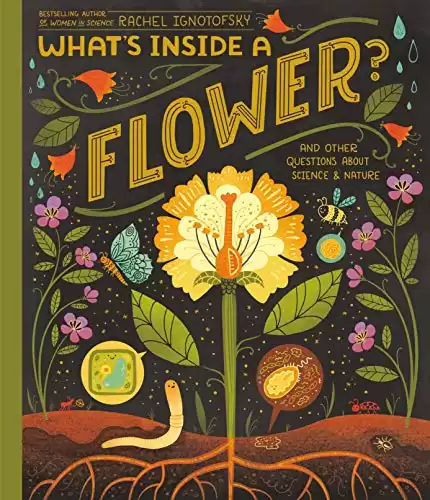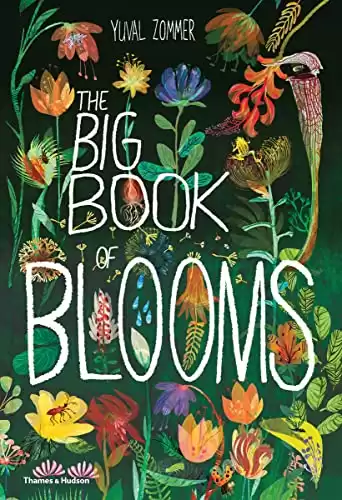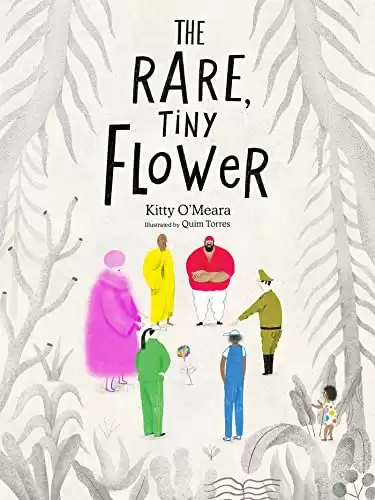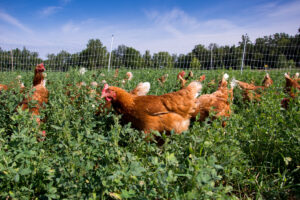| Best for | Product |
|---|---|
| Best Overall | What’s Inside A Flower?: And Other Questions About Science & Nature |
| Best for Toddlers | Mrs. Peanuckle’s Flower Alphabet (Mrs. Peanuckle’s Alphabet) |
| Best for Children | Big Book of Blooms (The Big Book Series) |
| Best Illustrated | Look! Flowers! |
| Best Activity Book | Learning About Wildflowers (Dover Little Activity Books) |
| Best Lesson-Inspired | The Rare, Tiny Flower: (Picture Books about Peace, Kindness Kids Books) |
You can communicate so many different sentiments with flowers. They even have their own secret language. They fill gardens in the spring and their unique scents fill homes during birthdays and other special events. Children see a wondrous world all around them, and learning more about it helps them get more plugged into the environment in which they live. Whether flowers enthrall your kiddo and they appreciate taking a more scientific perspective or they simply enjoy them in real life, photography, and illustrations, there’s a book in the list below that works perfectly for your little one.
We highlight the best children’s books about flowers, and we even include a book about the anatomy of flowers. It teaches children what’s inside a flower, answering their many questions. Babies and toddlers may not be able to read just yet but that doesn’t mean they can’t start early! They can learn the alphabet while learning about flowers with a fun, colorful board book! The other options include an activity book, one with gorgeous illustrations, and a lesson-inspired book to instill those very important life lessons better learned early on.
 Check Amazon
Check Amazon- Nonfiction picture book that helps young scientists grow their understanding of the natural world
- Distinctive art style, brimming with color
- This book aims to teach children about science and inquiry.
- This book is available in Kindle, audio, hardcover, and paperback formats.
 Check Amazon
Check Amazon- Flower alphabet book teaches about all flowers ranging from the aster to the zinnia
- Share this with your child to have something exciting to remember
- This book is available as a board book or on Kindle
- Teaches young children about 26 different types of flowers and their defining characteristics and fun facts.
 Check Amazon
Check Amazon- Gorgeous illustrations of flowers fill these pages
- Great for young readers
- Includes both beautiful and strange flowers from around the globe
- Teaches children about botany and how to identify various flower species
 Check Amazon
Check Amazon- Suitable for children between three and six years old
- Beautiful illustrations
- The writing style is smooth but playful
- The flowers are illustrated in incredible detail.
 Check Amazon
Check Amazon- Incorporates tons of facts and features 12 distinct flowers
- Perfect size to travel with
- This book is very budget-friendly
- Each flower has its own sticker and detailed description
 Check Amazon
Check Amazon- Written by a best-selling author
- Delivers lessons for children on tolerance, divisiveness, differences, and unity
- The illustrations are powerful and complement the story well
- The story is told in rhyming verse
Top Picks: The Best Children’s Books About Flowers to Satisfy Their Curiosities
#1 Overall Best: What’s Inside a Flower? And Other Questions About Science & Nature by Rachel Ignotofsky
The best overall children’s book about flowers is What’s Inside a Flower? And Other Questions About Science & Nature by Rachel Ignotofsky. This book is available in Kindle, audio, hardcover, and paperback formats. The author, Rachel Ignotofsky, is the creator of the New York Times best-seller Women in Science. What’s Inside a Flower? is a nonfiction picture book that helps young scientists grow their understanding of the natural world. This book starts with illustrating and explaining what is inside a flower. If you have a budding backyard scientist on your hands, this book makes a great gift. It helps them explore their outside world with a fabulous introduction to flowers. It touches on everything from seeds to roots to blooms.
The author of this book aims to teach children about science and inquiry, so they have those building blocks ready to keep exploring their natural curiosity. Her book answers all the questions children have about flowers and she likely answers some of your adult questions as well. Ignotofsky has a very distinctive art style, and her text is always engaging and wildly informative. Each spread throughout the book is brimming with color. Although she keeps the text concise, the art is expansive, flawlessly complementing each new piece of information.
Pros and Cons of What’s Inside a Flower? And Other Questions About Science & Nature by Rachel Ignotofsky
| Pros | Cons |
|---|---|
| This book is available in Kindle, audio, hardcover, and paperback formats. | |
| The author is also the creator of the New York Times best-seller Women in Science. | |
| This is an engaging non-fiction book that provides an excellent introduction to flowers and the natural world. | |
| The book aims to teach children about science and inquiry. | |
| The illustrations are beautiful and full of color. | |
| There is a lot of information in the book, but it is presented in a clear and concise manner. |
- Nonfiction picture book that helps young scientists grow their understanding of the natural world
- Distinctive art style, brimming with color
- This book aims to teach children about science and inquiry.
- This book is available in Kindle, audio, hardcover, and paperback formats.
2. Best for Toddlers: Mrs. Peanuckle’s Flower Alphabet by Mrs. Peanuckle (Author) and Jessie Ford (Illustrator)
Start babies and toddlers young with this great gift Mrs. Peanuckle’s Flower Alphabet. It is available on Kindle, but the default version is a board book. This flower alphabet book teaches about all flowers ranging from the aster to the zinnia. Mrs. Peanuckle narrates this book, and she introduces your very young child to 26 different types of flowers found throughout the world. As she presents each flower, she also offers a single defining characteristic. Some of these tidbits of information are quite surprising.
For example, there are twice as many orchid species as there are bird species! She also teaches children that butterflies, bees, and birds love the taste of flowers. She even teaches children that some people use flowers in their teas. Each page is bold and colorful with striking graphic art. The book is part of a series of board books and you can certainly explore more to celebrate other aspects of nature like bugs, vegetables and fresh fruits, and trees.
Mrs. Peanuckle’s Flower Alphabet is a fun way to review the alphabet and learn different flowers all at the same time. The art in this book is illustrated with fun and colorful designs. However, one customer did say that she would have preferred if it included more actual photographs or realistic drawings but overall, she feels it makes a great addition to her child’s library.
Pros and Cons of Mrs. Peanuckle’s Flower Alphabet by Mrs. Peanuckle (Author) and Jessie Ford (Illustrator)
| Pros | Cons |
|---|---|
| This book is available as a board book or on Kindle. | There are no actual photographs or realistic drawings in this book. |
| It teaches young children about 26 different types of flowers and their defining characteristics and fun facts. | |
| The book is filled with bright and colorful illustrations. | |
| This is a fun book to help children learn the alphabet and learn about different flowers at the same time. |
- Flower alphabet book teaches about all flowers ranging from the aster to the zinnia
- Share this with your child to have something exciting to remember
- This book is available as a board book or on Kindle
- Teaches young children about 26 different types of flowers and their defining characteristics and fun facts.
3. Best Educational: Big Book of Blooms by Yuval Zommer
Big Book of Blooms by Yuval Zommer is a fantastic nonfiction book that offers children an excellent introduction to scientific concepts and a lush garden of plant life. Zommer’s enchanting illustrations breathe life into a myriad of vibrant, extravagant, and distinctive flowers from all over the world.
In this book, young readers can dive into the realm of botany, gaining knowledge on how to identify various flower species. In addition, the book depicts diverse terrains where various flowers live, like giant water lilies, pitcher plants, carnivorous and toxic flowers, and even the bizarre and beautiful corpse flower!
Big Book of Blooms also educates readers on the vulnerability of some flowers that are threatened and endangered and helps children to gain insight into why some blooms are colorful or smell sweet. This book is the perfect combination of captivating illustrations and straightforward, enlightening content. The eccentric and colorful illustrations crafted by Zommer will captivate young readers and provide insight into the earth’s most fascinating flowers.
Pros and Cons of Big Book of Blooms by Yuval Zommer
| Pros | Cons |
|---|---|
| This is a beautifully illustrated nonfiction book that provides an excellent introduction to the scientific world of plants and flowers. | |
| The illustrations are bold, whimsical, and colorful. | |
| The book depicts all types of beautiful and strange flowers from around the globe. | |
| Children will also learn about their diverse habitats. | |
| The author includes flowers that are endangered and threatened as well. | |
| The book explains why some flowers are colorful and why others smell nice. | |
| There is a lot of information in this book, but it is presented in a captivating and straightforward manner. |
- Gorgeous illustrations of flowers fill these pages
- Great for young readers
- Includes both beautiful and strange flowers from around the globe
- Teaches children about botany and how to identify various flower species
4. Best Illustrated: Look! Flowers! by Stephanie Calmenson (Author) and Puy Pinillos (Illustrator)
Look! Flowers! is a colorful nonfiction book that introduces flowers to your kiddos. It invites your child to appreciate the delicate beauty of many different kinds of flowers found throughout the world. The book covers some more common flowers and also incorporates a few surprising, exotic flowers. Your child gets to learn about tall sunflowers, sweet asters, colorful roses, moon flowers, and even the amazing Venus fly trap. This book also includes a gatefold at the end for your child to explore even more types of gorgeous flowers. It’s suitable for children between three and six years old.
This book is illustrated with multiple flowers across each page, accompanied by a catchy rhyme describing either a unique feature of the flower or an interesting fact about it. The writing style is smooth and has a playful feel that perfectly complements the flower facts. The illustrations are bright and colorful and show the flowers in a detailed way that you don’t usually get to see in children’s books. At the end of the book, there are even more flowers and their names, which is great if you’re a slightly older preschooler who likes gardening and learning about flowers. The author has picked lots of different flowers to keep things interesting, and along with the beautiful pictures, this book is definitely one to have in your collection.
Pros and Cons of Look! Flowers! by Stephanie Calmenson (Author) and Puy Pinillos (Illustrator)
| Pros | Cons |
|---|---|
| The lovely illustrations in this book are bright and colorful. | |
| Each page is illustrated with multiple flowers and a catchy rhyme describing a unique feature of a flower or an interesting fact about it. | |
| The writing style is smooth but playful. | |
| The flowers are illustrated in incredible detail. | |
| The gatefold at the end of the book has even more flowers and their names for more learning. | |
| The book includes both common and unusual flowers. | |
| It’s suitable for children between three and six years old. |
- Suitable for children between three and six years old
- Beautiful illustrations
- The writing style is smooth but playful
- The flowers are illustrated in incredible detail.
5. Best Activity Book: Learning About Wildflowers by Dot Barlowe
Learning About Wildflowers is a fun activity book that is also very budget-friendly. It’s available in paperback format. The book incorporates tons of facts and features 12 distinct flowers that grow in different places like the woods and fields. Some of those flowers include the goldenrod, black-eyed Susan, buttercup, Indian paintbrush, New England aster, and jack in the pulpit. Each flower has a detailed description. Children take one of each of the 12 flower stickers and place it on its corresponding description.
This is one of the best children’s books about flowers and it delivers great value and contains tons of fun information. It’s a small book but it’s very enjoyable. Its small size is perfect to keep in the car or in a diaper bag.
Pros and Cons of Learning About Wildflowers by Dot Barlowe
| Pros | Cons |
|---|---|
| This book is very budget-friendly. | This book is quite small. |
| It is available in paperback. | |
| The book includes many facts and features 12 distinct flower species. | |
| Each flower has its own sticker and detailed description. | |
| Children take one of each of the 12 flower stickers and place it on its corresponding description. | |
| The book is small and is perfect to keep on hand in the car or in a diaper bag. |
- Incorporates tons of facts and features 12 distinct flowers
- Perfect size to travel with
- This book is very budget-friendly
- Each flower has its own sticker and detailed description
6. Best Lesson-Inspired: The Rare, Tiny Flower by Kitty O’Meara (Author) and Quim Torres (Illustrator)
For a book that incorporates flowers and an important life lesson, The Rare, Tiny Flower is a must-read. Kitty O’Meara is a best-selling author who writes stories in a way that offers wisdom to relevant situations. She aims to deliver hope for growth. In this book, she explores a couple of different themes on tolerance, divisiveness, differences, and unity. She aims to teach children about their agency and tells the story in a rhyming verse. The accompanying illustrations are very powerful, perfectly complementing the story.
Throughout the book, a mysterious flower in the middle of a forest appears as a different color to each new viewer. This difference in perception leads to strife because everyone insists that the way they view the flower is the correct way. There are botanists and world leaders who are unable to reach an agreement on the nature of this mysterious flower. They end up declaring war as a way to resolve the conflict. A young girl harnesses her courage to point out that the flower is multi-dimensional. She manages to get the arguing masses to see her vision. She helps them rebuild bridges of communication as they commit to connecting with one another and respecting their different perspectives.
Many customers have come to know O’Meara because of her first book, And the People Stayed Home, which is about the pandemic. O’Meara delivers The Rare, Tiny Flower just as powerfully as she did the first time. The book’s message is essential, and customers highly recommend this work to other conscientious parents looking to teach their children valuable life lessons. If you’re looking for one of the very best children’s books about flowers, this is a must-read!
Pros and Cons of The Rare, Tiny Flower by Kitty O’Meara (Author) and Quim Torres (Illustrator)
| Pros | Cons |
|---|---|
| Kitty O-Meara is the best-selling author of And the People Stayed Home. | |
| The author offers depth and wisdom to relevant situations. | |
| The story is told in rhyming verse. | |
| The illustrations are powerful and complement the story well. | |
| The story gives an example of how we each have a different perspective, and how to rebuild bridges of communication and respect different perspectives. | |
| The book helps children to understand their own agency and power to create change. |
- Written by a best-selling author
- Delivers lessons for children on tolerance, divisiveness, differences, and unity
- The illustrations are powerful and complement the story well
- The story is told in rhyming verse
Criteria: What to Look for in Children’s Books About Flowers
Most children are easily pleased when they get a book that caters to their interests. However, it’s important to consider all the different types of flower books there are for kiddos to explore. Here are some things to consider when picking out a children’s book on flowers:
- Reading level
- Interest
- Quality
- Illustrations
Reading Level
Knowing your child’s reading level is crucial when choosing books for them to read. Each child has their own unique reading level, which is determined by their vocabulary, sentence structure, and comprehension skills. By selecting books that are appropriate for your child’s reading level, you can ensure that they will be able to read the book without struggling, feel confident about their reading ability, and comprehend (and enjoy!) the story.
If your child is still young and does not read yet, that’s okay! Reading to your children is just as important as having them read on their own!
If your young reader is at a more advanced reading level and you are looking to instill some life lessons through a flower book, make sure you pick up a book that challenges your kiddo and presents an important life lesson they can take with them as they grow.
Interest
To gift them with a foundational understanding of what flowers are, what their anatomy is, and how they come about, it’s best to choose a fact-based book with a little bit of science that teaches children the basics. You may not have a science-minded child initially but if their interest in flowers is strong enough, they are likely to develop a little bit more of an interest in scientific concepts.
Of course, you always want to cater to their interests in a much more fun and engaging way than sometimes the scientific concepts (which can feel a bit dry for some kids). If that’s the case, make sure to incorporate an activity book, a coloring book, or even a fiction book about flowers. Sometimes books anthropomorphize flowers and that becomes a great way to get kiddos engaged with reading.
Quality
Reading books with fact-based, quality information can help children develop critical thinking and problem-solving skills as they encounter new ideas and concepts. In addition, good-quality books can foster positive attitudes and encourage a love of reading, which can stay with a child throughout their lifetime.
Illustrations
Illustrations are a critical component of children’s books because they help to bring the story to life on the page. Young children may not yet have developed the language skills to fully understand a story’s words, so illustrations can help convey its meaning. Good illustrations can also capture a child’s attention, sparking their curiosity, imagination, and wonder. Colorful and vibrant illustrations can help to make reading more fun and engaging for children who might otherwise find books difficult to engage with. Well-crafted books that are beautifully illustrated can help develop a child’s imagination, enhance their vocabulary, and promote literacy skills.
| Best for | Product |
|---|---|
| Best Overall | What’s Inside A Flower?: And Other Questions About Science & Nature |
| Best for Toddlers | Mrs. Peanuckle’s Flower Alphabet (Mrs. Peanuckle’s Alphabet) |
| Best for Children | Big Book of Blooms (The Big Book Series) |
| Best Illustrated | Look! Flowers! |
| Best Activity Book | Learning About Wildflowers (Dover Little Activity Books) |
| Best Lesson-Inspired | The Rare, Tiny Flower: (Picture Books about Peace, Kindness Kids Books) |
The 6 Best Children’s Books About Flowers to Satisfy Their Curiosities FAQs (Frequently Asked Questions)
Can books help children learn about flowers and gardening?
Yes! Books about flowers can be a great way to introduce children to the world of gardening and flowers. They can help kids learn about the different types of flowers, how flowers grow, and the importance of taking care of nature.
What is the most popular flower?
Roses are certainly one of the most popular types of flowers. They are the go-to flower for many couples as they often symbolize romance. Roses, however, also symbolize friendship and can be a wonderful way to communicate your fondness for others. They are gorgeous flowers that can be gifted as a single flower, in a bouquet with other roses, or in a bouquet with other flowers.
What does a flower symbolize?
That depends on the specific flower but, in general, flowers are a symbol of happiness and pleasure. You may even be curious enough to learn about the language of flowers. For example, daisies symbolize true love while a white rose communicates “I cannot.” A yellow pansy communicates to the receiver that you’re thinking of them, and pink flowers are a way to communicate “yes.”
Thank you for reading! Have some feedback for us? Contact the AZ Animals editorial team.




